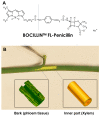Tracing Penicillin Movement in Citrus Plants Using Fluorescence-Labeled Penicillin
- PMID: 31842435
- PMCID: PMC6963813
- DOI: 10.3390/antibiotics8040262
Tracing Penicillin Movement in Citrus Plants Using Fluorescence-Labeled Penicillin
Abstract
Huánglóngbìng (HLB), citrus greening, is one of the most destructive diseases of citrus plants worldwide. In North America, HLB is caused by the phloem-limited bacterium Candidatus Liberibacter asiaticus and is transmitted by the Asian citrus psyllid, Diaphorina citri. No cure exists at present, and the use of antibiotics for the control of HLB has gained interest due to the significant losses to the citrus industry. Because of unsatisfactory results when using foliar applications of antibiotics, concerns were raised regarding the uptake and translocation of these materials within trees. We, therefore, investigated a method that allows us to study the movement of antibiotic materials in citrus plants. Herein, we utilized a fluorescence-labeled penicillin, BOCILLINTM FL-Penicillin (FL-penicillin), to study the uptake and translocation of penicillin in citrus plants. FL-penicillin was applied by puncture to the stem of young citrus seedlings and was traced by using fluorescence microscopy. After application, we detected FL-penicillin in the leaves and in the stem xylem and phloem tissues above and below the application site in both intact and partially bark-girdled citrus seedlings, indicating that it is easily taken up and transported through the plant vascular system. In addition, we detected FL-penicillin in the gut of D. citri, which were allowed to feed on the treated plants, suggesting translocation of this molecule into the vascular tissue. We propose that the use of fluorescent-labeled molecules could be an effective tool for understanding the uptake and translocation of antibiotics and other macromolecules in plants and insects.
Keywords: BOCILLINTM FL-Penicillin; Huanglongbing (HLB); citrus; phloem; translocation; uptake; xylem.
Conflict of interest statement
The authors declare no conflicts of interest.
Figures




References
-
- Reinking O.A. Diseases of economic plants in southern China. Philipp. Agric. 1919;8:109–135.
Grants and funding
LinkOut - more resources
Full Text Sources

